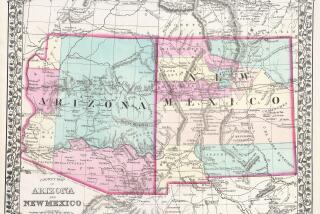Holder opens inquiry of CIA interrogations
The Obama administration Monday set the country on a course to confront whether actions taken in the name of defending Americans instead crossed criminal lines.
In simultaneous moves, Atty. Gen. Eric H. Holder Jr. opened an investigation into whether CIA interrogators broke the law and the administration complied with a judge’s order and released a long-secret CIA report that cataloged allegations of agency prisoner abuse.
The administration also released memos sought in recent months by former Vice President Dick Cheney that he argued attest to the success of the CIA’s controversial methods, but that appeared inconclusive in part because the agency had blacked out large portions of the memos.
The release of the report by the CIA’s inspector general provided the most comprehensive account to date of the interrogation program, with previously undisclosed details such as prisoners being choked to the point of passing out or threatened with harm to their families.
The administration sought to limit the impact of Monday’s moves, which it appeared to make with some reluctance. Holder described the inquiry as “preliminary,” and the White House left many pages of the CIA report blacked out.
But fallout from the decisions could prove difficult to contain.
The investigation is likely to intensify an already bitter battle in Washington over whether to punish career intelligence officials for how they executed the Bush administration’s counter-terrorism campaign.
The investigation means that CIA counter-terrorism officials could face criminal scrutiny for years at a time when the agency and the Justice Department are supposed to be part of a seamless counter-terrorism team and contributing to a new elite interrogation outfit, which was also unveiled Monday.
CIA Director Leon E. Panetta, who had fought both the criminal investigation and the release of the inspector general’s report, issued a statement to agency employees Monday describing the details of the document as “an old story.”
“For the CIA now, the challenge is not the battles of yesterday, but those of today and tomorrow,” Panetta said.
In announcing the inquiry, Holder concluded that there was enough evidence to warrant a fresh examination of whether federal law had been violated. He said he realized the decision “will be controversial,” but added: “It is clear to me that this review is the only responsible course of action for me to take.”
To lead the review, Holder tapped Assistant U.S. Atty. John H. Durham of Connecticut, who in 2008 was appointed by the Bush administration to investigate the destruction of CIA videotapes of detainee interrogations.
Durham already has assembled a team of investigators who will determine whether the preliminary review turns up enough evidence to warrant a criminal investigation.
Holder’s decision to open the investigation was driven to a large degree by his reaction to reading the CIA inspector general report earlier this year.
The report was issued in 2004. Officials within the Justice Department at the time reviewed the document and opted to keep it secret. The report became available to the public, at least in part, for the first time Monday as the result of an ACLU lawsuit. The document includes new disclosures on how top Al Qaeda prisoners were told that their families faced harm if they didn’t cooperate.
“We could get your mother in here,” a CIA interrogator told Abd al Rahim al Nashiri, the man suspected of plotting the 2000 bombing of the U.S. destroyer Cole, according to the report. The threat was meant to prey on fears in the Middle East that prisoners are made to witness the sexual abuse of their relatives.
Khalid Shaikh Mohammed, the self-proclaimed mastermind of the Sept. 11 attacks, was told, “If anything else happens in the United States, ‘We’re going to kill your children,’ ” according to the report.
In some cases, the report praises how the CIA prisons were run, and acknowledges that the program provided valuable intelligence. During a 19-month stretch after the Sept. 11 attacks, the report said, the interrogation program accounted for 3,000 intelligence reports, providing the agency with much of its understanding of Al Qaeda.
Interrogations “provided intelligence that has enabled the identification and apprehension of other terrorists and warned of terrorist plots,” the report said. Even so, the report concluded that the effectiveness of particular techniques “cannot be so easily measured,” raising the question of whether the enhanced methods had been crucial to collecting that data.
But the report also faults CIA personnel across agency ranks for failures in oversight and abuses in the interrogation booth. In one passage, the document warns that the agency’s activities “are inconsistent with the public policy positions that the United States has taken regarding human rights.” The document also cites the anxieties of CIA case officers fearful they would one day be held to account.
“One officer expressed concern that one day, agency officers will wind up on some ‘wanted list’ to appear before the World Court,” the report said.
The report describes cases in which the CIA turned to off-the-books methods, including mock execution and threatening a prisoner with a gun and a power drill.
One previously undisclosed method was known as “pressure points,” and involved applying pressure to a prisoner’s carotid artery “to the point that the detainee would nod and start to pass out” before being shaken awake.
Many of the incidents described in the document have been previously disclosed. The report expresses deep misgivings, for example, about the simulated drowning method known as waterboarding.
Two prisoners were subjected repeatedly to that method, despite deep concern among the agency’s own medical staff, as well as explicit language in Justice Department memos warning against such repetition. The method appears to be the subject of a 23-page section of the report that was nearly completely blacked out.
But even in laying out potential violations of U.S. anti-torture laws, the document contains details that underscore how difficult it could be to obtain convictions.
The excessive use of waterboarding, for example, appears to have been sanctioned by then-Atty. Gen. John Ashcroft, who “confirmed that DOJ approved of the expanded use of various” techniques.
There are new indications that CIA higher-ups sometimes pushed for the use of brutal tactics even after interrogators believed a prisoner was cooperating.
The opinions of CIA officials at headquarters “are not always supported by an objective evaluation,” and were often based on inflated “presumptions of what the individual might or should know,” according to the report.
The report was produced by former CIA Inspector General John L. Helgerson, who issued a statement Monday saying he was “disappointed” that the government did not declassify large segments of the document, including the recommendations he issued to address problems the report identified.
President Obama outlawed the CIA’s use of so-called enhanced interrogation techniques in January and ordered the secret prisons closed.
But he has come under criticism for dismantling programs that Republicans, led by Cheney, argue were crucial to keeping the country safe.
In recent months, the former vice president has pushed for the declassification of two documents he said would bolster his argument.
After the administration released them, Cheney issued a statement to the Weekly Standard saying the documents show he was right. The documents “clearly demonstrate that the individuals subjected to enhanced interrogation techniques provided the bulk of intelligence we gained about Al Qaeda,” he said Monday night. “This intelligence saved lives and prevented terrorist attacks.”
However, the documents provide few details on what role, if any, enhanced interrogation methods played in getting terrorists to talk.
One is titled “Detainee Reporting Pivotal for the War Against Al Qaeda.” But it indicates that officials believe some top Al Qaeda leaders talked simply because they believed the CIA already had the information from other detainees.
The other document focuses on Mohammed, who gave up crucial information about Al Qaeda’s weapons of mass destruction program because “he apparently calculated -- incorrectly -- that we had this information already.”
--
greg.miller@latimes.com
--
BEGIN TEXT OF INFOBOX
John H. Durham
Age: 59
Position: First assistant U.S. attorney for the District of Connecticut.
Current portfolio: Tapped by Bush administration Atty. Gen. Michael B. Mukasey in January 2008 to investigate the CIA in the 2005 destruction of interrogation videotapes. He serves as acting U.S. attorney for the Eastern District of Virginia for the purposes of that matter. Durham “is a widely respected and experienced career prosecutor who has supervised a wide range of complex investigations in the past,” Mukasey said.
Background: A 30-plus-year veteran of the Justice Department, he has won praise for being one of the nation’s most relentless prosecutors. Durham was appointed in 1999 by then-U.S. Atty. Gen. Janet Reno to investigate whether FBI agents and police officers in Boston for three decades were working with organized crime, an inquiry that led to numerous convictions of public officials and charges of misconduct and influence peddling. He also evaluated, prepared and prosecuted major racketeering cases directed at the Gambino, Genovese and Patriarca crime families in Connecticut.
Personal: Publicity-shy, perhaps due to his specialty in prosecuting organized crime. He is a registered Republican, according to press reports citing Connecticut voter records. He has four sons.
Source: Associated Press
More to Read
Get the L.A. Times Politics newsletter
Deeply reported insights into legislation, politics and policy from Sacramento, Washington and beyond. In your inbox three times per week.
You may occasionally receive promotional content from the Los Angeles Times.






